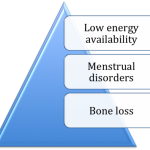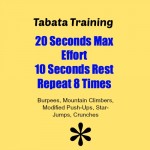

The Female Athlete Triad 13 Comments Thursday, June 20th, 2013 As a dietitian, I’ve worked with a variety of individuals (ranging from those with eating disorders to neurological conditions) improve their health through nutrition and other lifestyle modifications. Often times when I meet with clients, the desired goal is weight loss, but when it comes to women that can come at a cost.Whenever we talk about weight loss everyone has theories on what constitutes the “best” program. For some people, that means doing a very low carbohydrate/ketogenic approach, for others that means focusing on that “old school” calories in vs calories out equation. Whatever the method you use to get there, there is one thing we all need to consider. Women are fragile.Now, before you start attacking that statement and showing me how many 200 lb snatches you can do, let me rephrase that statement. Women’s hormones are fragile. For this very reason I am extremely prudent when working with women who want to tinker with intermittent fasting, frequent metabolic conditioning greater than 20 minutes, very low carbohydrate diets, or other stressful lifestyle “hacks,” as some call it.There has been some discussion about this in the community and for that I am very grateful. Just as we talk about certain foods or diets not fitting into a one-size-fits-all model, we absolutely need to take into consideration the differences between the female and male anatomy when it comes to handling stressors.Women’s health is my passion. I am dedicated to having women understand how their bodies work and empowering them to take actions that help support their beautiful temple. With that being said, I’d love to introduce a topic to this community that hasn’t really been discussed.Enter: The Female Athlete Triad.So what IS the Female Athlete Triad?The word triad signifies three, so it makes sense that this syndrome would include three different interrelated conditions. These three problems include:Low energy availability/intake – this is with or without an eating disorder Menstrual disturbances – amenorrhea or irregular cycles Bone loss – osteoporosis/osteopenia *Please check out Figure 1 from the position paper by ACSM for a fantastic model showing the progression of the triad here.As I mentioned before, these conditions are interrelated. If a female athlete is experiencing one of the conditions of the triad, the others should also be considered.An example of how these conditions flow together is as follows:Scenario:A female athlete is trying to maintain her lean body composition and struggles with an eating disorder. She is not consuming adequate calories to meet the requirements of her sport and due to this calorie deficit she starts to lose her cycle. She may go a few months, or even years, without having a period. The stress from the low energy intake starts reprioritizing which hormones she makes and her sex hormones get the back seat. She is now looking at a low estrogen state, even having a sex hormone panel similar to a post-menopausal woman. Since estrogen is important factor in bone health, the lack of estrogen prompts bone loss. One day during practice, she ends up fracturing her foot even though there was minimal impact to the area.Who is at risk?Any female is susceptible to the triad, but it is commonly seen in female athletes whose sports emphasize low body weight or leanness – think gymnasts, ballerinas, or endurance runners. The female doesn’t have to be an athlete nor do they need to be in a sport that emphasizes leanness. It could simply just be a woman who is restricting her calorie intake.**As a side note: while it is not technically called the Female Athlete Triad for guys, energy deficits can also lead to problems with bone health and hormone disturbances for men too. Low testosterone anyone? It doesn’t matter who you are or what sport you play, there has to be balance. Too few calories and too much exercise is a recipe for hormonal havoc.Problems associated with the triadLow nutrient intake:When we’re looking at a low energy intake, we also need to think of a likely low micronutrient (vitamin/mineral) intake. The female is probably not getting adequate building blocks for proper bone formation in addition to having low estrogen.Do you think having a low bone density is a problem for a female athlete? Most definitely. Think about sports where the body is constantly “pounding the pavement” or participating in high impact sports. You’re just “cruisin’ for a bruisin’” if your bones are weak. And what about the fact that during your reproductive years your bones are building their potential? You’re putting the breaks on a very important time for peak bone density.In fact, sometimes women have no idea that they are experiencing the female athlete triad until they present to the doctor with a broken bone. It sounds crazy, but even signs and symptoms, such as a lack of a monthly period, become second thoughts to these women. Sometimes they are even happy about not having to DEAL with a monthly cycle. This is not okay. Women are supposed to have monthly cycles during their reproductive years. Fertility is a sign of health – whether or not you want to get pregnant.
Source:
The Female Athlete Triad – Robb Wolf

















 For now classes are 6pm and 640pm at 2840 Wildwood st in the Boise Cloggers studio.
Book your class NOW!
click this ==>
For now classes are 6pm and 640pm at 2840 Wildwood st in the Boise Cloggers studio.
Book your class NOW!
click this ==>








